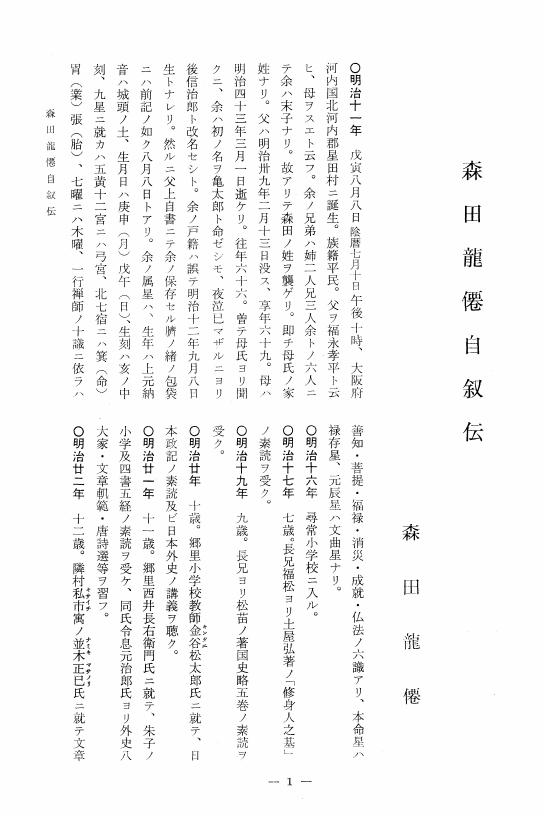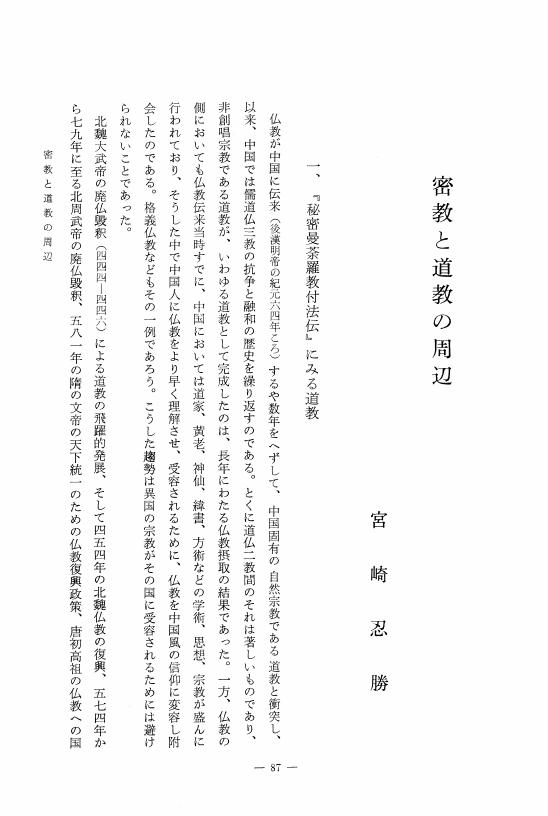2 0 0 0 OA 鎌倉仏教における戒律の宗派化
- 著者
- 上田 霊城
- 出版者
- 密教研究会
- 雑誌
- 密教文化 (ISSN:02869837)
- 巻号頁・発行日
- vol.1975, no.112, pp.1-29, 1975-12-20 (Released:2010-03-12)
2 0 0 0 OA 菩薩思想の源流についての一考察
- 著者
- 藤村 隆淳
- 出版者
- 密教研究会
- 雑誌
- 密教文化 (ISSN:02869837)
- 巻号頁・発行日
- vol.1983, no.142, pp.1-10, 1983-03-21 (Released:2010-03-12)
2 0 0 0 OA 弘法大師の上表文における文章構造の特色 (上)
- 著者
- 静 慈圓
- 出版者
- 密教研究会
- 雑誌
- 密教文化 (ISSN:02869837)
- 巻号頁・発行日
- vol.1976, no.114, pp.1-23, 1976-03-30 (Released:2010-03-12)
- 著者
- 大柴 清圓
- 出版者
- 密教研究会
- 雑誌
- 密教文化 (ISSN:02869837)
- 巻号頁・発行日
- vol.2008, no.220, pp.L77-L106,179, 2008-03-21 (Released:2010-03-12)
- 参考文献数
- 15
The transmission of the Dafoding tuoluoni _??__??__??__??__??__??_ in Shingon Buddhism dates back to Vajrabodhi (671-741). Vajrabodhi learned this dharani in India and brought it to China, where he wrote the Xinyi fanhan dafoding tuoluoni _??__??__??__??__??__??__??__??__??__??_ Amoghavajra (705-774) met Huiguo _??__??_ (746-806), and was deeply impressed by his promising talent. Amoghavajra orally taught Huiguo the Dafoding tuoluoni and the Dasuiqiu tuoluoni _??__??__??__??__??__??_ in Sanskrit. Huiguo displayed marvelous results upon reciting these, surprising all. Kukai _??__??_ (774-835) received from Huiguo the Sanskrit texts and Chinese transliteration of these, and returned with them to Japan. Among the three courses for yearly ordinands _??__??__??__??_, he included the Dafoding tuoluoni and Dasuiqiu tuoluoni in the shomyo-go _??__??__??_, thus establishing them within Shingon-shu. Subsequently, Engyo _??__??_ (79 9-852), Eun _??__??_ (798-869), Jogyo _??__??_ (?-866), and Shuei _??__??_ (809-884) all brought buddhosnisa-related texts to Japan. These were carefully transmitted by Shinzei _??__??_ (800-860), Shunnyu _??__??_ (890-953), GOho _??__??_ (1306-1362), Kakudo _??__??_ (1500-1527), Jogon _??__??_ (1639-1702), Renta _??__??_ (1663-1726), Jiun _??__??_ (1718-1804), Shozen _??__??_ (1676-1763), Yuten _??__??_ (?-1915), and others. The Dafoding tuoluoni was recited daily in Shingon-shu probably until about the middle of the twentieth century.The Zhu dafoding zhenyan _??__??__??__??__??__??_ has been described as the composition of Nanchu _??__??_, (?-847) of Tendai. This paper will demonstrate that it was imported to Japan by Engyo but not including in his catalogue, and will also introduce commentary that places the Dafoding tuoluoni among the five *buddhosnisa. Based on that classification, the author will discuss the content of the Dafoding tuoluoni, and as a result describe its nature as strongly of the abhicaraka type.
2 0 0 0 OA 大元帥明王考
- 著者
- 森田 龍僊
- 出版者
- 密教研究会
- 雑誌
- 密教研究 (ISSN:18843441)
- 巻号頁・発行日
- vol.1942, no.80, pp.1-20, 1942-02-01 (Released:2010-03-12)
2 0 0 0 OA 大日經題の研究 (上編)
- 著者
- 金山 穆韶
- 出版者
- 密教研究会
- 雑誌
- 密教研究 (ISSN:18843441)
- 巻号頁・発行日
- vol.1940, no.75, pp.47-57, 1940-12-15 (Released:2010-03-12)
2 0 0 0 OA 仏教声楽としての声明沿革史小観 (上)
- 著者
- 大山 公淳
- 出版者
- 密教研究会
- 雑誌
- 密教研究 (ISSN:18843441)
- 巻号頁・発行日
- vol.1927, no.24, pp.17-47, 1927-04-01 (Released:2010-03-16)
2 0 0 0 OA 中部ジャバの密教
- 著者
- 干潟 龍祥
- 出版者
- 密教研究会
- 雑誌
- 密教文化 (ISSN:02869837)
- 巻号頁・発行日
- vol.1965, no.71-72, pp.73-104, 1965-04-01 (Released:2010-03-12)
2 0 0 0 OA 寛治二年白河上皇高野御幸記 (二)
- 著者
- 和多 昭夫
- 出版者
- 密教研究会
- 雑誌
- 密教文化 (ISSN:02869837)
- 巻号頁・発行日
- vol.1961, no.52, pp.50-54, 1961-03-15 (Released:2010-03-12)
2 0 0 0 OA 東寺講堂の諸尊と三輪身説
- 著者
- 下松 徹
- 出版者
- 密教研究会
- 雑誌
- 密教文化 (ISSN:02869837)
- 巻号頁・発行日
- vol.1987, no.157, pp.50-66, 1987-01-21 (Released:2010-03-12)
2 0 0 0 OA 初期仏教における頭陀行について
- 著者
- 永崎 亮寛
- 出版者
- 密教研究会
- 雑誌
- 密教文化 (ISSN:02869837)
- 巻号頁・発行日
- vol.1980, no.129, pp.L88-L76, 1980-02-21 (Released:2010-03-12)
2 0 0 0 OA 纔発心転法輪菩薩考
- 著者
- 谷川 泰教
- 出版者
- 密教研究会
- 雑誌
- 密教文化 (ISSN:02869837)
- 巻号頁・発行日
- vol.1999, no.202, pp.1-44, 1999-03-31 (Released:2010-03-12)
2 0 0 0 多田等観日記に見る真言宗と「喇嘛教」 : 満洲国建国前後を中心に
- 著者
- 高本 康子
- 出版者
- 密教研究会
- 雑誌
- 密教文化 (ISSN:02869837)
- 巻号頁・発行日
- no.233, pp.116-101, 2014-12
2 0 0 0 OA ヨーガ・ヤージュニャヴァルキヤの文献学的考察
- 著者
- 高木 伸元
- 出版者
- 密教研究会
- 雑誌
- 密教文化 (ISSN:02869837)
- 巻号頁・発行日
- vol.1970, no.92, pp.L1-L34, 1970-09-28 (Released:2010-03-12)
2 0 0 0 OA 元禄五年流罪の行人方僧の名簿
- 著者
- 日野西 真定
- 出版者
- 密教研究会
- 雑誌
- 密教文化 (ISSN:02869837)
- 巻号頁・発行日
- vol.1984, no.145, pp.68-84, 1984-01-21 (Released:2010-03-12)
1 0 0 0 OA ウパニシャッド・スートラ時代の社会と法
- 著者
- 中野 義照
- 出版者
- 密教研究会
- 雑誌
- 密教文化 (ISSN:02869837)
- 巻号頁・発行日
- vol.1975, no.110, pp.1-34, 1975-03-25 (Released:2010-03-12)
1 0 0 0 OA 般若経と文殊菩薩
- 著者
- 氏家 昭夫
- 出版者
- 密教研究会
- 雑誌
- 密教文化 (ISSN:02869837)
- 巻号頁・発行日
- vol.1976, no.115, pp.12-24, 1976-09-30 (Released:2010-03-12)
1 0 0 0 OA 森田龍僊自叙伝
- 著者
- 森田 龍僊
- 出版者
- 密教研究会
- 雑誌
- 密教文化 (ISSN:02869837)
- 巻号頁・発行日
- vol.1974, no.105, pp.1-19, 1974-02-15 (Released:2010-03-12)
1 0 0 0 OA 密教と道教の周辺
- 著者
- 宮崎 忍勝
- 出版者
- 密教研究会
- 雑誌
- 密教文化 (ISSN:02869837)
- 巻号頁・発行日
- vol.1987, no.159, pp.87-102, 1987-09-21 (Released:2010-03-12)
1 0 0 0 OA 法華の密教化に関する私見
- 著者
- 長部 和雄
- 出版者
- 密教研究会
- 雑誌
- 密教文化 (ISSN:02869837)
- 巻号頁・発行日
- vol.1954, no.26, pp.38-47, 1954-03-20 (Released:2010-03-12)

















